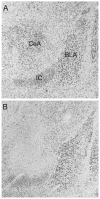Role of amygdala central nucleus in feature negative discriminations
- PMID: 22889308
- PMCID: PMC3468906
- DOI: 10.1037/a0029600
Role of amygdala central nucleus in feature negative discriminations
Abstract
Consistent with a popular theory of associative learning, the Pearce-Hall (1980) model, the surprising omission of expected events enhances cue associability (the ease with which a cue may enter into new associations), across a wide variety of behavioral training procedures. Furthermore, previous experiments from this laboratory showed that these enhancements are absent in rats with impaired function of the amygdala central nucleus (CeA). A notable exception to these assertions is found in feature negative (FN) discrimination learning, in which a "target" stimulus is reinforced when it is presented alone but nonreinforced when it is presented in compound with another, "feature" stimulus. According to the Pearce-Hall model, reinforcer omission on compound trials should enhance the associability of the feature relative to control training conditions. However, prior experiments have shown no evidence that CeA lesions affect FN discrimination learning. Here we explored this apparent contradiction by evaluating the hypothesis that the surprising omission of an event confers enhanced associability on a cue only if that cue itself generates the disconfirmed prediction. Thus, in a FN discrimination, the surprising omission of the reinforcer on compound trials would enhance the associability of the target stimulus but not that of the feature. Our data confirmed this hypothesis and showed this enhancement to depend on intact CeA function, as in other procedures. The results are consistent with modern reformulations of both cue and reward processing theories that assign roles for both individual and aggregate error terms in associative learning.
PsycINFO Database Record (c) 2012 APA, all rights reserved
Figures






Similar articles
-
Mini-review: Prediction errors, attention and associative learning.Neurobiol Learn Mem. 2016 May;131:207-15. doi: 10.1016/j.nlm.2016.02.014. Epub 2016 Mar 3. Neurobiol Learn Mem. 2016. PMID: 26948122 Free PMC article. Review.
-
Effects of reward timing information on cue associability are mediated by amygdala central nucleus.Behav Neurosci. 2011 Feb;125(1):46-53. doi: 10.1037/a0021951. Behav Neurosci. 2011. PMID: 21319887 Free PMC article.
-
Consolidation of altered associability information by amygdala central nucleus.Neurobiol Learn Mem. 2016 Sep;133:204-213. doi: 10.1016/j.nlm.2016.07.016. Epub 2016 Jul 15. Neurobiol Learn Mem. 2016. PMID: 27427328 Free PMC article.
-
The influence of associability changes in negative patterning and other discriminations.J Exp Psychol Anim Behav Process. 2000 Oct;26(4):462-76. doi: 10.1037//0097-7403.26.4.462. J Exp Psychol Anim Behav Process. 2000. PMID: 11056886
-
Parallel processing of information about location in the amygdala, entorhinal cortex and hippocampus.Hippocampus. 2013 Nov;23(11):1075-83. doi: 10.1002/hipo.22179. Hippocampus. 2013. PMID: 23929819 Review.
Cited by
-
Effects of amygdala lesions on overexpectation phenomena in food cup approach and autoshaping procedures.Behav Neurosci. 2016 Aug;130(4):357-75. doi: 10.1037/bne0000149. Epub 2016 May 12. Behav Neurosci. 2016. PMID: 27176564 Free PMC article.
-
Posterior insular cortex is necessary for conditioned inhibition of fear.Neurobiol Learn Mem. 2016 Oct;134 Pt B(Pt B):317-27. doi: 10.1016/j.nlm.2016.08.004. Epub 2016 Aug 11. Neurobiol Learn Mem. 2016. PMID: 27523750 Free PMC article.
-
Mini-review: Prediction errors, attention and associative learning.Neurobiol Learn Mem. 2016 May;131:207-15. doi: 10.1016/j.nlm.2016.02.014. Epub 2016 Mar 3. Neurobiol Learn Mem. 2016. PMID: 26948122 Free PMC article. Review.
References
-
- Cotton MM, Goodall G, Mackintosh NJ. Inhibitory conditioning resulting from a reduction in the magnitude of reinforcement. Quarterly Journal of Experimental Psychology. 1982;34B:163–180. - PubMed
-
- Dickinson A, Hall G, Mackintosh NJ. Surprise and the attenuation of blocking. Journal of Experimental Psychology: Animal Behavior Processes. 1976;2:313–322.
MeSH terms
Grants and funding
LinkOut - more resources
Full Text Sources
Miscellaneous

